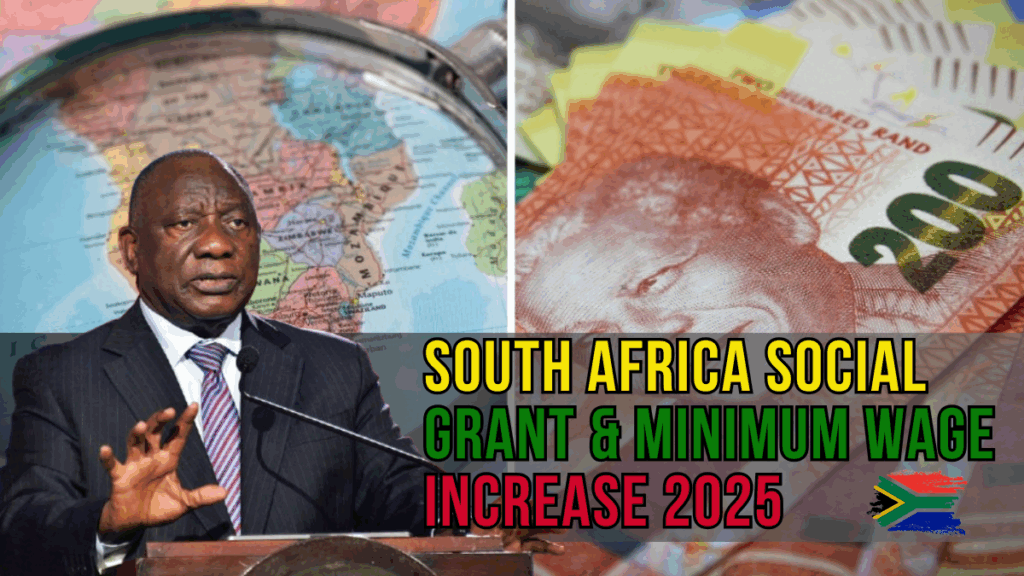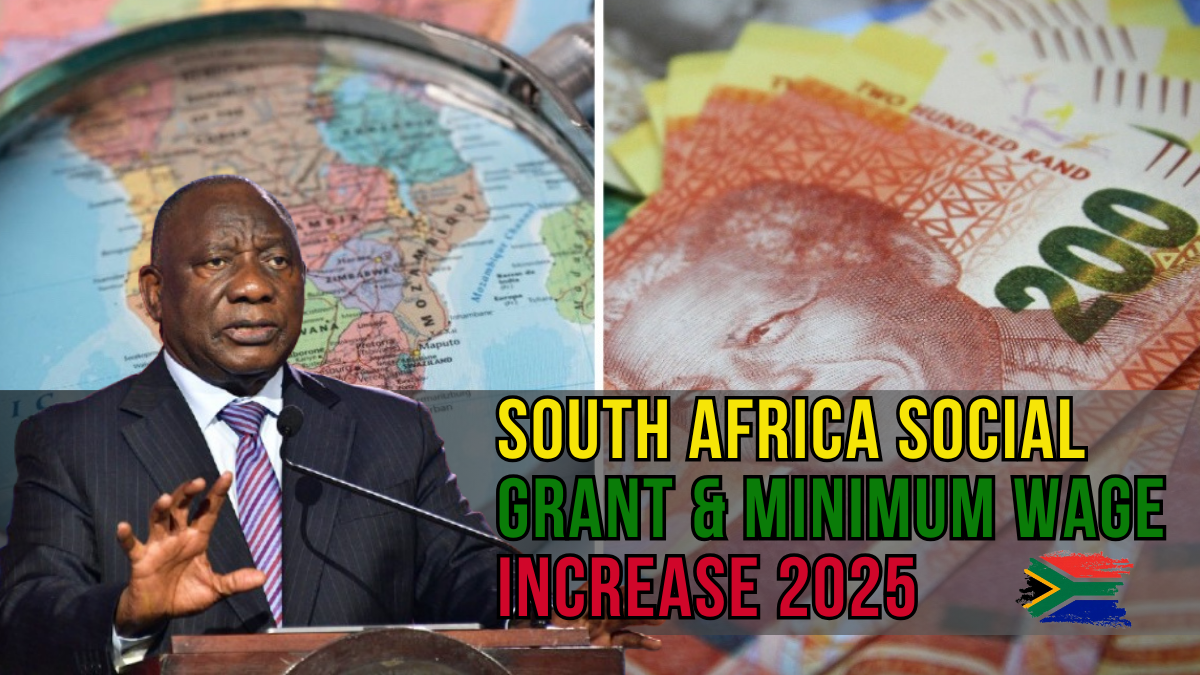In 2025, the South African government has implemented a significant boost to its social protection and economic equity programs, announcing increases to key social grants and raising the National Minimum Wage. These policy changes aim to provide relief to millions of South Africans grappling with rising costs of living, inflation, and unemployment.

From grant recipients such as pensioners and caregivers to domestic workers and farmworkers, these changes are expected to have a wide-reaching impact. This detailed guide breaks down the new grant amounts, minimum wage rates, who benefits, and how it contributes to the broader goals of economic inclusion.
Summary Table: Social Grant & Minimum Wage Increase 2025
Policy Area |
Updated Details for 2025 |
|---|---|
SRD Grant |
Increased from R350 to R370 per month |
Old Age, Disability Grants |
Periodic increases based on inflation and economic trends |
Child Support Grant |
Scheduled for regular increment updates |
Minimum Wage |
Raised to R28.79/hour (from March 2025) |
Beneficiaries |
Low-income households, caregivers, pensioners, workers |
Governing Bodies |
SASSA, Department of Social Development, DoL |
Official Website |
What’s New in 2025: Key Highlights
- Social Relief of Distress (SRD) Grant increased by R20, now totaling R370/month.
- Core Social Grants (Old Age, Disability, Child Support) to receive scheduled increases.
- National Minimum Wage raised to R28.79 per hour, benefiting millions of workers.
- New rates aim to offset inflation, reduce poverty, and promote dignity and equity.
2025 SRD Grant Update: From R350 to R370
The Social Relief of Distress (SRD) Grant was introduced as a temporary support mechanism during the COVID-19 pandemic. Since then, it has become a permanent form of aid for unemployed South Africans with no other sources of income.
Why the Increase?
Although the R20 monthly rise may appear small, for millions of grant recipients, it makes a noticeable difference—especially for those relying on it for:
- Daily food purchases
- Transport costs for job hunting
- Mobile data for online applications
- Toiletries and other essentials
The government has committed to reviewing the SRD grant amount regularly in response to inflation and economic shifts.
Increases in Other Social Grants
1. Old Age Grant
The Old Age Grant supports senior citizens aged 60 or above. For many, this is the sole income source in retirement. While specific monthly increases are announced quarterly, the general trend in 2025 is toward incremental growth aligned with inflation.
2. Disability Grant
For individuals with long-term physical or mental disabilities, the grant remains a vital lifeline. Monthly increases are expected throughout the year to maintain purchasing power.
3. Child Support Grant
Caregivers and parents of minor children benefit from this grant. In 2025, the base amount and additional top-ups for orphans or vulnerable children will also be adjusted in line with inflation.
These core grants are administered by SASSA, which has announced a proactive strategy of frequent revisions based on the Consumer Price Index (CPI) and real-time inflation data.
Minimum Wage Adjustment: New Floor for Workers in 2025
As of March 1, 2025, South Africa’s National Minimum Wage is officially increased to:
R28.79 per hour
This increase aligns with the government’s economic development strategy, aiming to ensure that no worker earns below a dignified wage. This wage applies to both urban and rural workers, with additional focus on:
- Entry-level employees
- Domestic workers
- Farmworkers
- Cashiers and retail assistants
- Learners in government-approved training programs
Minimum Wage Breakdown by Worker Category
Worker Type |
2025 Rate per Hour |
|---|---|
General Employees |
R28.79 |
Domestic Workers |
R27.67 |
Farmworkers |
R28.25 |
Learnerships/Stipends |
Varies by program |
These rates are enforced under labour law, and any employer found paying below the minimum threshold can face legal consequences, including fines and penalties.
Who Benefits from These 2025 Increases?
1. Social Grant Recipients
- Pensioners
- Persons with disabilities
- Caregivers
- Unemployed individuals
These groups will see monthly financial improvements that allow for better access to food, schooling, medical services, and transportation.
2. Workers in Low-Wage Sectors
- Domestic and farm workers, who were previously below the standard national rate
- Staff in hospitality, cleaning, and retail sectors
- Workers in informal or part-time employment
This boost enables improved financial independence and reduces dependency on family or state grants.
3. Low-Income Families
Households that include both a wage earner and a grant recipient will experience a dual income increase, fostering:
- Better budgeting
- Improved savings
- Long-term stability
4. Youth and Job Seekers
While many young South Africans rely on the SRD grant, the adjusted minimum wage creates a more viable entry-level job market, offering slightly better starting salaries.
Why These Increases Were Necessary
South Africa’s economy has been under pressure due to:
- Rising fuel and electricity prices
- Escalating food inflation
- High unemployment rates
- Load shedding and business disruptions
In response, the 2025 grant and wage adjustments are designed to mitigate these challenges by improving household resilience and ensuring citizens maintain a minimum standard of living.
Government departments like the Department of Social Development, Department of Employment and Labour, and SASSA have reiterated their commitment to building a more equitable, just, and inclusive economy.
Economic Impact and Social Inclusion
Beyond individual financial relief, these policy changes are expected to:
- Stimulate local economies through increased consumer spending
- Reduce social unrest and inequality
- Encourage job creation in sectors that rely on minimum-wage labor
- Protect child welfare, nutrition, and school attendance
These efforts align with South Africa’s Vision 2030 under the National Development Plan (NDP) to eradicate poverty and reduce inequality.
Official Guidelines and Compliance
- Employers must update their payroll systems by March 2025.
- All workers are entitled to demand compliance.
- Complaints can be filed via the Department of Employment and Labour.
SASSA has also reminded beneficiaries to keep their contact details, ID numbers, and banking information up to date to avoid disruptions in grant payments.
Frequently Asked Questions (FAQs)
Q1: How much is the SRD Grant in 2025?
A: It has increased from R350 to R370 per month as of 2025.
Q2: What is the new national minimum wage?
A: The new rate is R28.79 per hour, effective from March 1, 2025.
Q3: Will other grants like Old Age or Disability increase?
A: Yes, these grants will receive regular quarterly or inflation-linked increases.
Q4: Who qualifies for the SRD Grant?
A: South African citizens or permanent residents aged 18–60 with no income, social grant, or UIF payment.
Q5: Where can I apply or check updates?
A: Visit https://www.sassa.gov.za or contact your nearest SASSA office.
Official Links
- SASSA Official Portal: https://www.sassa.gov.za
- Department of Employment and Labour: https://www.labour.gov.za
Conclusion
The 2025 increases to South Africa’s Social Grants and Minimum Wage reflect a meaningful step toward a more inclusive and equitable economy. While challenges remain, these adjustments will offer immediate relief to millions and help chart a path toward financial stability, social protection, and improved dignity for the nation’s most vulnerable.
Citizens are encouraged to stay informed, ensure their information is up to date, and report any violations of wage laws to the appropriate authorities. The road to economic justice continues, and 2025 represents a crucial milestone in that journey.
Click HERE for more
